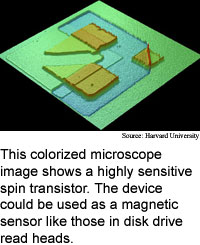
Avalanches up disk storage
The key to making storage media that crams
information into smaller spaces is making read devices sensitive enough
to read the magnetic orientation of tinier areas of magnetic film. The
1s and 0s of computer information are stored in magnetic media as magnetic
orientations.
Researchers from Harvard University and the University of California
at Santa Barbara have constructed a spin-valve transistor that is more
sensitive to microscopic magnetic fields than the devices that read today's
commercial hard drives.
The current traveling through both a giant magnetoresistance read
head and a spin-valve transistor varies depending on the relative magnetic
orientation of a pair of thin ferromagnetic films. When the magnetic orientations
of the two layers of film are parallel, current flows because electrons
are able to pass through both films to the transistor's output terminal.
When the magnetic orientations are not parallel, the electrons are unable
to pass through, reducing the current in the output terminal.
Spin valve transistors use hot, or high-energy electrons, which
makes them very sensitive. Hot electrons do not generate a lot of current,
however, making for weak signals.
Spin-valve transistors fall short of the performance of today's
giant magnetoresistance-type devices because the device has difficulty
distinguishing random fluctuations, or noise, from true signals. The researchers
boosted the signal-to-noise ratio of a spin-valve system by boosting its
output using a method pioneered in solid-state photodetectors. The method
involves causing one electron to excite another, each of which can excite
another electron, causing an avalanche-type reaction that results in a
stronger signal.
The device is 10 to 100 times more sensitive than giant magnetoresistance
read heads, according to the researchers.
The avalanche spin-valve transistor could be ready for use in
commercial magnetic storage technologies within the next five to ten years,
according to the researchers. The work appeared in the November 8, 2004
issue of Applied Physics Letters.
Snapshots save digital evidence
Software organizes email by task
Wire guides terahertz waves
How it Works Files:
Pattern Recognition
Briefs:
Quantum crypto scheme goes one-way
Method makes double nanotubes
Material promises denser DVDs
Artificial cochlea tells tones apart
Nanotubes boost molecular devices
Avalanches up disk storage
Silicon chip laser goes continuous

Research Watch blog
View from the High Ground Q&A
How It Works
RSS Feeds:
News
Ad links:
Buy an ad link
Ad links: Clear History
Buy an ad link
|
TRN
Newswire and Headline Feeds for Web sites
|
© Copyright Technology Research News, LLC 2000-2010. All rights reserved.